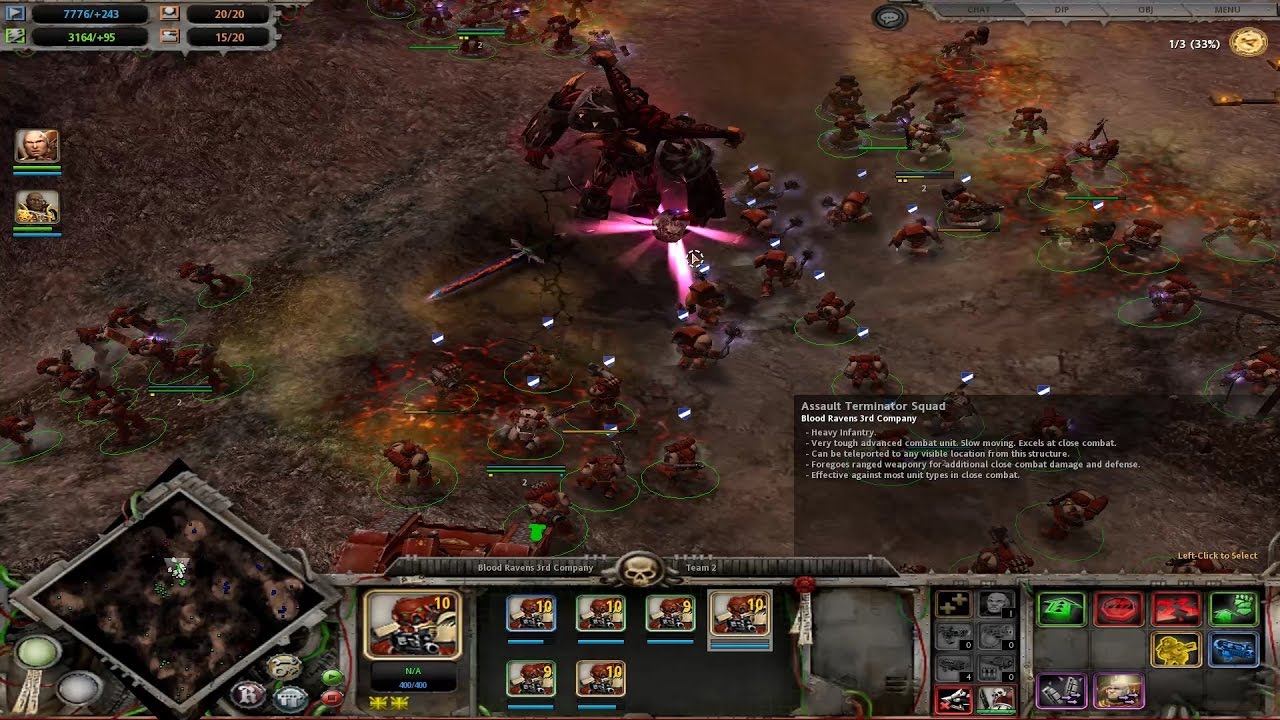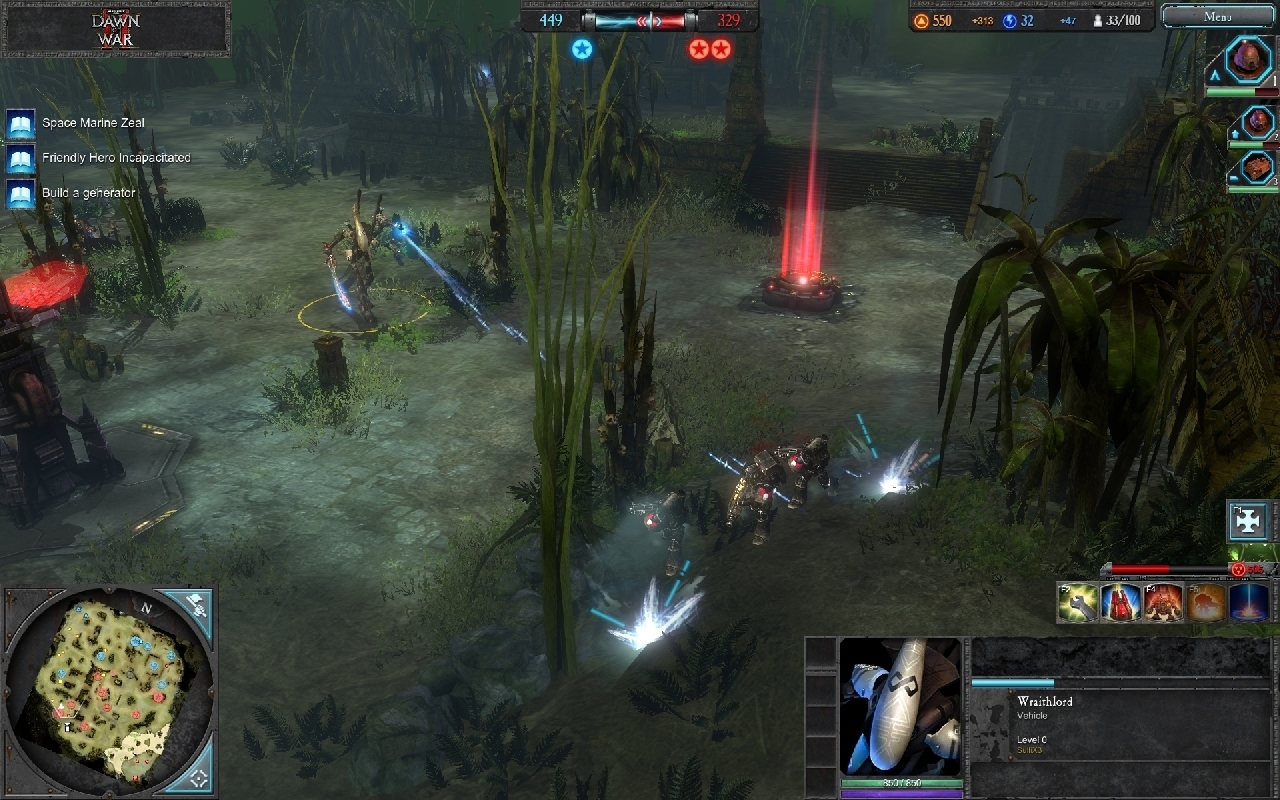Search
[{{{type}}}] {{{reason}}}
{{/data.error.root_cause}}{{{_source.title}}} {{#_source.showPrice}} {{{_source.displayPrice}}} {{/_source.showPrice}}
{{#_source.showLink}} {{/_source.showLink}} {{#_source.showDate}}{{{_source.displayDate}}}
{{/_source.showDate}}{{{_source.description}}}
{{#_source.additionalInfo}}{{#_source.additionalFields}} {{#title}} {{{label}}}: {{{title}}} {{/title}} {{/_source.additionalFields}}
{{/_source.additionalInfo}}Warhammer 40,000: Dawn of War (PC)

Warhammer 40,000: Dawn of War
Developed by: Relic Entertainment
Published by: THQ (Defunct), SEGA
Released: September 20, 2004
Available on: Microsoft Windows
Genre: Real-Time Strategy
ESRB Rating: M for Mature: Blood and Gore, Violence
Number of Players: Singleplayer, Multiplayer (up to 8 players)
Price: $12.99
(Humble Store Link)
"In the grim darkness of the far future, there is only war."
This phrase showcases the introduction to a gaming tabletop franchise called Warhammer 40,000, a universe set in the 41st millennium, in which peace is a distant memory, and the realm of man is under siege by all kinds of aliens and daemonic entities alike. However, Games Workshop, owner of the tabletop franchise, dared to enter into the market of video games with this product. In 2004, developer Relic Entertainment released a Real-Time Strategy game called Dawn of War, set in the Warhammer 40,000 universe. The monetary success of the game allowed for the release of several expansions to the game itself, like "Dawn of War: Winter Assault", "Dawn of War: Dark Crusade", and "Dawn of War: Soulstorm". However, this review will be mostly aimed at the original game, the first Dawn of War.
The game allows you to play as several factions, all of them with their different playing styles: the Space Marines, the superhuman warriors of the Imperium, devoted to the worship of the God-Emperor; the war-hungry and brutish Orks, who despoil and pillage systems in great invasions called WAAAAGH's (I'm not joking, that's how they're called); the marauding Chaos Space Marines, remnants of the Space Marine Legions who were corrupted by a malignant force called Chaos, and betrayed the Imperium; and the enigmatic Eldar, an ancient race that once ruled the galaxy, now a shadow of its former self. The Space Marines focus mostly on a mix of both ranged and melee units, with most of their weaponry consisting of a mix of both ballistic and energy weaponry. They are the most accessible faction, and the easiest way to play them. The Orks follow a more "numbers over everything" approach. Individually, they are weaker than other units, but they are terrifying melee combatants, and if gathered in enough numbers, can overwhelm their opponents in a massive tide of green angry boys. The Chaos Space Marines work almost similarly to the Space Marines, except with the addition of cultists, daemons, and extravagant vehicle designs to their ranks. Finally, the Eldar put more emphasis on specialist units that can dominate the battlefield, as well as mobility. Speed and surprise are the Eldar's main strengths, and for that, they're the harder faction to play as, all things considered.
The game comes with several game modes which you can choose from: a Campaign mode for the main story of the game, a Skirmish mode for battles against the AI, and a Multiplayer mode. The campaign focuses on the war for an imperial planet called Tartarus. The planet is under siege by a vast Ork invasion, led by Warboss Orkamungus. With the Imperial Guard's defenses completely overwhelmed, the Space Marines, represented by the Blood Ravens, intervene to stem the tide. However, as the Space Marines struggle to keep the Ork invasion at bay, they will soon realize that something else has caused this conflict in the first place, and a far more sinister plot is being unfolded to them.
Gameplay-wise, this game follows the usual convention known to most RTSs, but with some modifications. You build up your base, gather resources, and build up an army to destroy the opponent's base. But as a whole, the game comes with innovations to the formula. There are two types of resources: Requisition, and Power. Power is gathered by building Plasma generators, but requisition is only gathered by conquering the map. There are three types of conquerable areas which the players have to look out for: Strategic Points, Critical Locations, and Relics.

Strong Points: An excellent RTS game set in the universe of Warhammer 40,000; large battles; variety of factions and playstyles; brilliant soundtrack
Weak Points: Steep learning curve; uncustomizable controls; some graphical errors
Moral Warnings: Real-Time strategy style combat; supernatural content; grimdark setting
Strategic Points are spread all over the map, which allows the players to gather requisition once they are captured. Critical Locations are important in the game mode of "Take and Hold", which focuses on the capture of said Critical Locations and holding it for a determined amount of time. Relics are the end-game points, which allows each of the factions to access their respective super units. For example, the Space Marines can requisition the Land Raider, a super-heavy transport armed with several anti-tank and anti-infantry weaponry. Said super units also share a really large health pool, which allows them to become powerful bulwarks on the battlefield. Most vehicles and infantry units come with specific upgrade systems. Said upgrades allows them to be equipped with more specialized and advanced weaponry that replaces their standard guns. The infantry as a whole comes in groups of squads, letting the encounters be of a rather large scale as a result.
Another important aspect to touch on the game is the addition of sync kills. When a melee unit depletes the HP of its opponent, the winner finishes the loser off in an over the top fashion. It serves two purposes: to provide visual spectacle, and to tie an enemy unit down, as the unit performing the animation is invulnerable while it takes place.
Graphically, the game has aged really well. Even 17 years later, the graphics have withstood the test of time. The explosion effects pack a big punch, so much so that it causes camera shakes when zoomed in. That also translates to the firing effects, causing camera shakes when a heavy weapon is being fired, like a Heavy Bolter, although some of the weapon effects can be hit and miss. The Space Marine regular Bolter, for instance, doesnt have a punchy sound effect that could feel satisfying, even sounding like a weak submachinegun. For context, the Bolter fires a .75 caliber round, with its bullets able to explode on impact.
The artstyle of the game itself is also really appealing for the fans of the setting. Its artstyle manages to portray the grim times of the 41st millennium in a very accurate way. Civilian buildings in the campaign have a neogothic flair to them, the Space Marines resemble medieval knights in space, and even the vehicles themselves show signs of the battles they have participated in, with scratched paintjobs and the humming of old engines trying to keep said vehicle going as long as it can.
The controls themselves are easy to follow, being the standard staple of any RTS game. The problem comes when sometimes, a keybind is not as intuitive as it should be, forcing you to use the Function keys. The function keys, from F1 to F7, change the stances of your troops, while F10 and F11 gives you access to the game menu and objectives menu. While F12 opens up the diplomacy submenu, it conflicts with one of the Steam overlay's keybinds, making you take a screenshot everytime you press it. The controls themselves cannot be changed in the game itself either, and there's no option to see the default keybind options.

Higher is better
(10/10 is perfect)
Game Score - 88%
Gameplay: 19/20
Graphics: 9/10
Sounds: 9/10
Stability: 5/5
Controls: 3/5
Morality Score - 68%
Violence: 5/10
Language: 8/10
Sexual Content: 10/10
Occult/Supernatural: 1/10
Moral/Cultural/Ethical: 10/10
On the topic of its moral content, it does have some aspects that could be found disturbing.
Violence is a prominent feature, being a real-time strategy game based on leading one force against another. There is a fair amount of blood and remaining corpses of fallen troops on both sides, but this can be toned down severely via the in-game options.
Language is rather tame, generally, as the universe setting tends towards a futuristic medieval dialogue with few if any foul words, though a few of generic religious meaning like h*ll and d*mn can show in rare instances. This mostly refers to the in-game daemons and their adherents. Sexual content is absent, this lacking any depiction of anything save sensibly clad warriors of varying races and no displays of sexual content or nudity.
As for the supernatural and occult, there is some content of that nature. The Chaos Space Marines, for instance, wear iconography that could be interpreted as demonic or satanic. As they are an enemy faction in the main campaign, however, players do not get access to it, except in the Skirmish and Multiplayer modes. The player does not have access to them in the canon campaign and further has no access to any supernatural or occult powers like necromancy, demon summoning, and so on.
There are no henious acts that the player is forced to do. The protagonist of the campaign, Gabriel Angelos, serves the Imperium loyally and courageously, and there is no way to deviate from that. Another kind of warning that could be made is that the setting itself is a bleak universe. It is a war-torn galaxy, with a decadent human empire trying to hold onto the domain of the stars one day longer. As such, while the setting itself may look bleak, the player is in no way forced to act on any acts that could be described as war crimes or atrocities as a whole, although Angelos notes in his diary how the civilian population of the planet is slowly dwindling due to both the Orks and the Forces of Chaos.
The game itself is a masterpiece of the RTS genre as a whole. While its graphical issues are hard to ignore, its gameplay is some of the more entertaining and fun aspects of a lot of RTS. Fans of the setting will appreciate it for the lengths it goes to in portraying the universe, and RTS fans will appreciate the scale of combat it offers to them. The quality of its expansions is also excellent, and worth taking a look at in the future.






